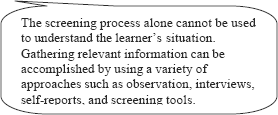
The observation screening process
Heading the list of the Tennessee Literacy Resource Center's recommendations for
screening incoming literacy participants is "Informal Observation and Work Samples."
The research group comprised of Tennessee practitioners found that careful observation
was so valuable to the assessment process that it recommended training to sharpen the
practitioner's observation skills."1

Role of the practitioner
Informally observing an adult's learning process, work samples and overall behaviour is an ongoing process. The practitioner is in a position to contribute valuable input. Practitioner observations provide further insights into the areas identified through the screening tools. Practitioners can observe any identified areas under a variety of circumstances to see if consistencies or differences exist. This helps to confirm or question potential learning disability indicators that may have been flagged during an intake interview and / or during the screening process.
Through observation, the practitioner can talk with the learner and gain further knowledge of his or her:
- Way of learning
- Learning strategies (what they have tried or what they would like to try)
- Preferences for materials, strategies and learning approaches
1 National Adult Literacy and Learning Disabilities Center (1995). Screening for Adults with Learning Disabilities; the Role of the Practitioner in the Assessment Process. Washington, DC. Obtained from the OTAN Database, reference ID: 1620.